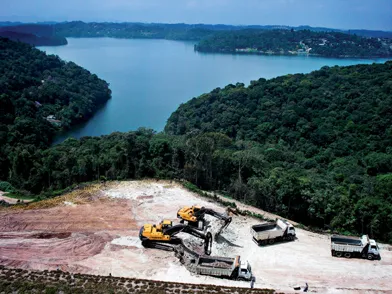The Brazilian city of Sao Paulo suffers a heavily congested road network. Huge traffic jams up to 100km long are common and can be even 200km long in bad weather or at weekends and holidays. Of the 1.1 million vehicles that drive into Sao Paulo every day, almost a third are passing through and the new Rodoanel Mario Covas orbital route is intended to tackle the problem. This is a 170km long highway around the city that will connect the 10 highways linking Sao Paulo and allow many vehicles to avoid the conge
July 10, 2012
Read time: 2 mins

The Brazilian city of Sao Paulo suffers a heavily congested road network. Huge traffic jams up to 100km long are common and can be even 200km long in bad weather or at weekends and holidays. Of the 1.1 million vehicles that drive into Sao Paulo every day, almost a third are passing through and the new Rodoanel Mario Covas orbital route is intended to tackle the problem. This is a 170km long highway around the city that will connect the 10 highways linking Sao Paulo and allow many vehicles to avoid the congested centre.
The work has been split into four stretches and the West section opened in 2002 although the others have been delayed. However, the highway is due for completion before 2014 and will cut truck traffic in Sao Paulo by over 40% in the worst affected places. The Southern section of the beltway is currently under construction, at a cost of US$1.7 billion. This 64km section will connect with the Western stretch and allow easier access to the port area. The project is being managed by Desenvolvimento Rodoviario SA (2529 Dersa), which has divided up the Southern section into five contracts. An accelerated construction programme will see handover in 2010, despite the need to construct 136 bridges and viaducts.
The second of the five lots is being managed by giants1305 Odebrecht and Constran. The 6.9km long project is complex as it features nine bridges, two overpasses and 12 underpasses, including cuts of up to 120m and fills of 60m being carried out by earthmoving contractor, Contern Construções e Comércio, which is part of the Bertin Group.
The equipment fleet Contern is using is mostly new as the firm invested over $14 million for this section.
The work has been split into four stretches and the West section opened in 2002 although the others have been delayed. However, the highway is due for completion before 2014 and will cut truck traffic in Sao Paulo by over 40% in the worst affected places. The Southern section of the beltway is currently under construction, at a cost of US$1.7 billion. This 64km section will connect with the Western stretch and allow easier access to the port area. The project is being managed by Desenvolvimento Rodoviario SA (
The second of the five lots is being managed by giants
The equipment fleet Contern is using is mostly new as the firm invested over $14 million for this section.





